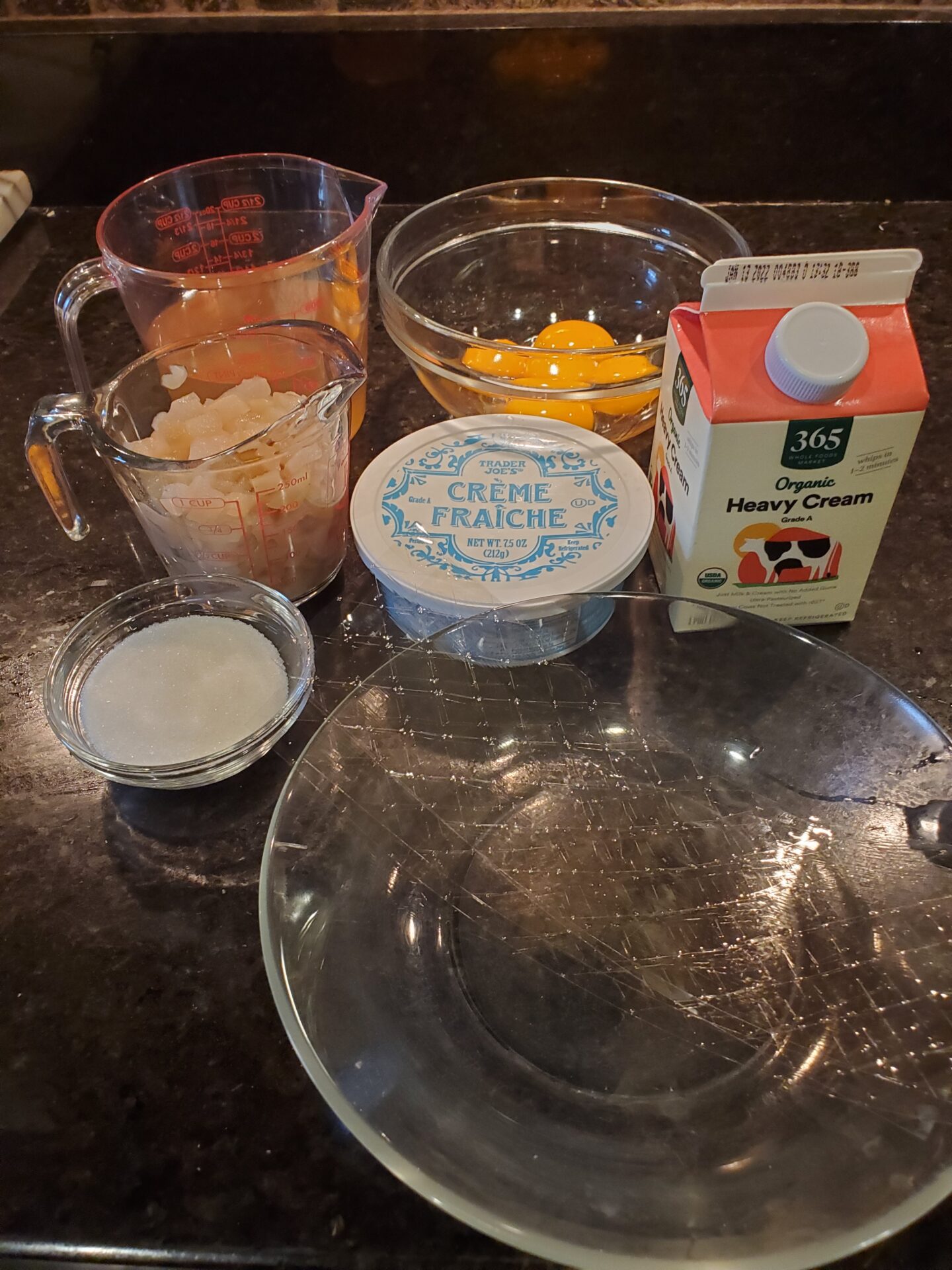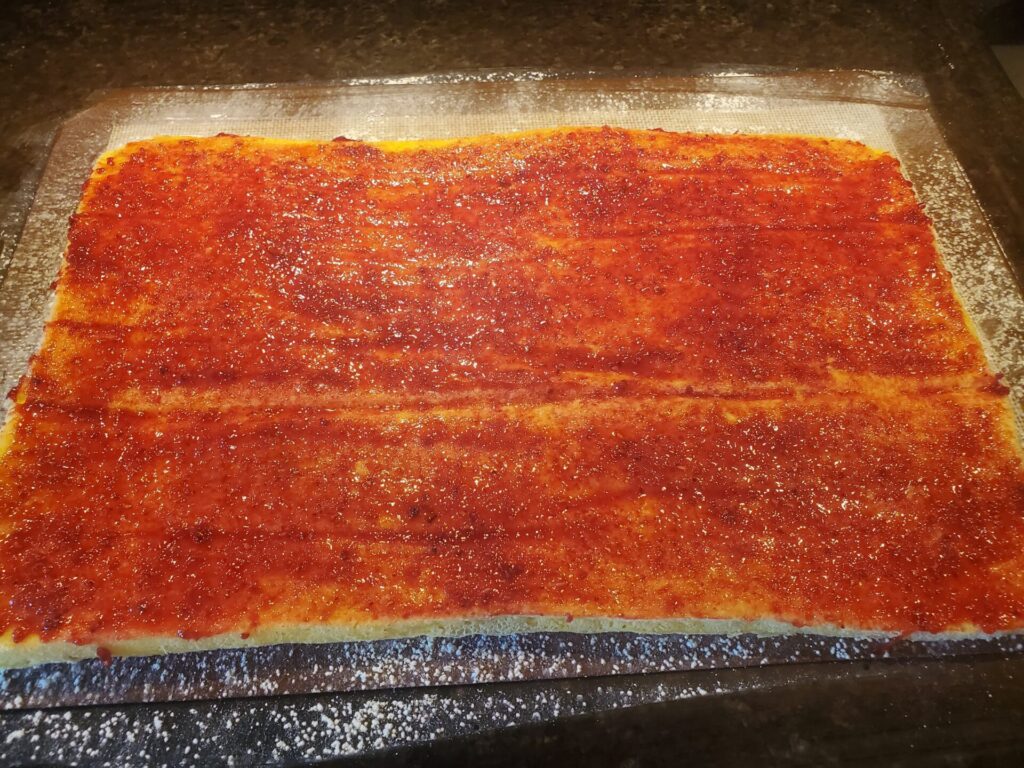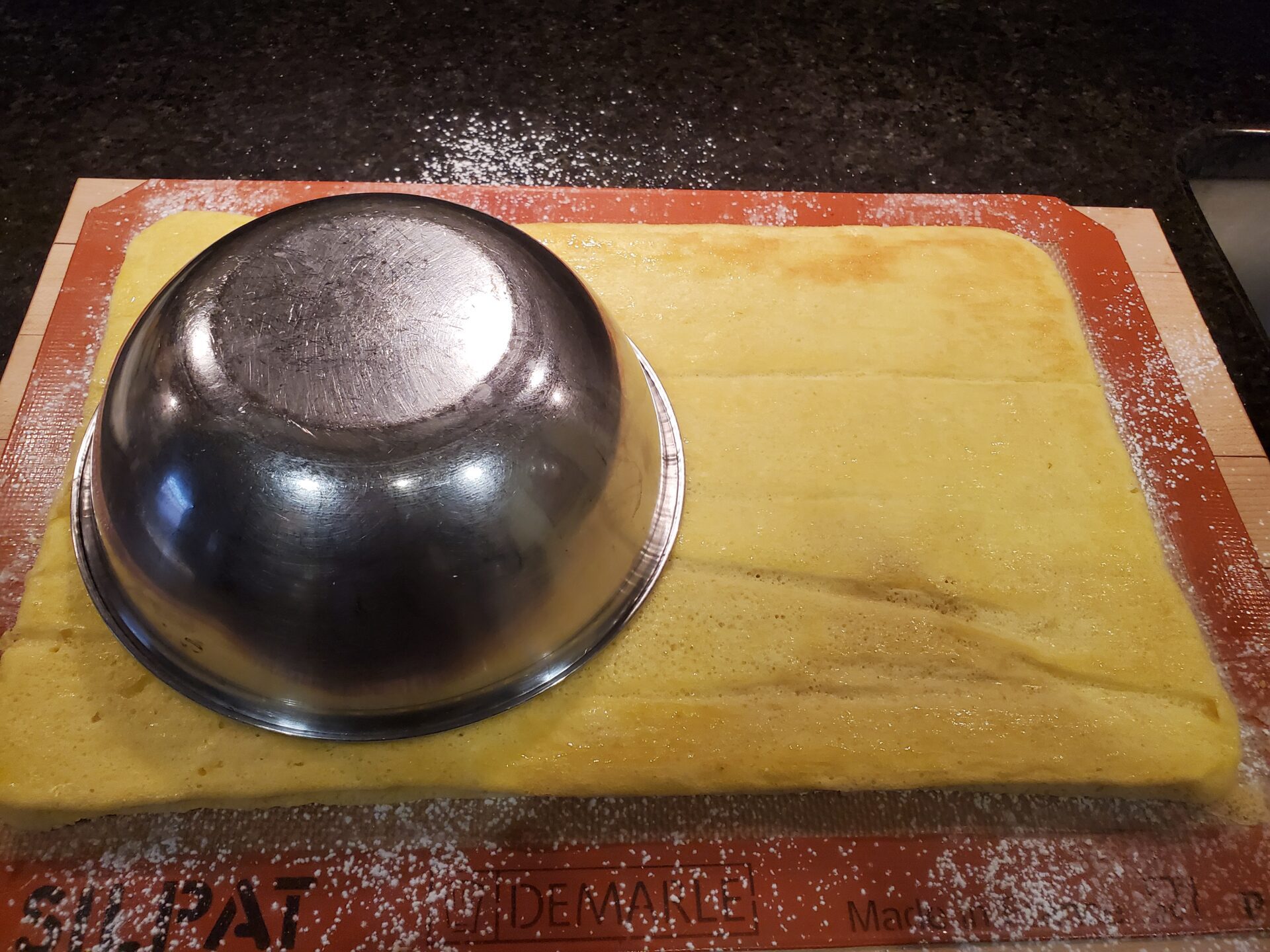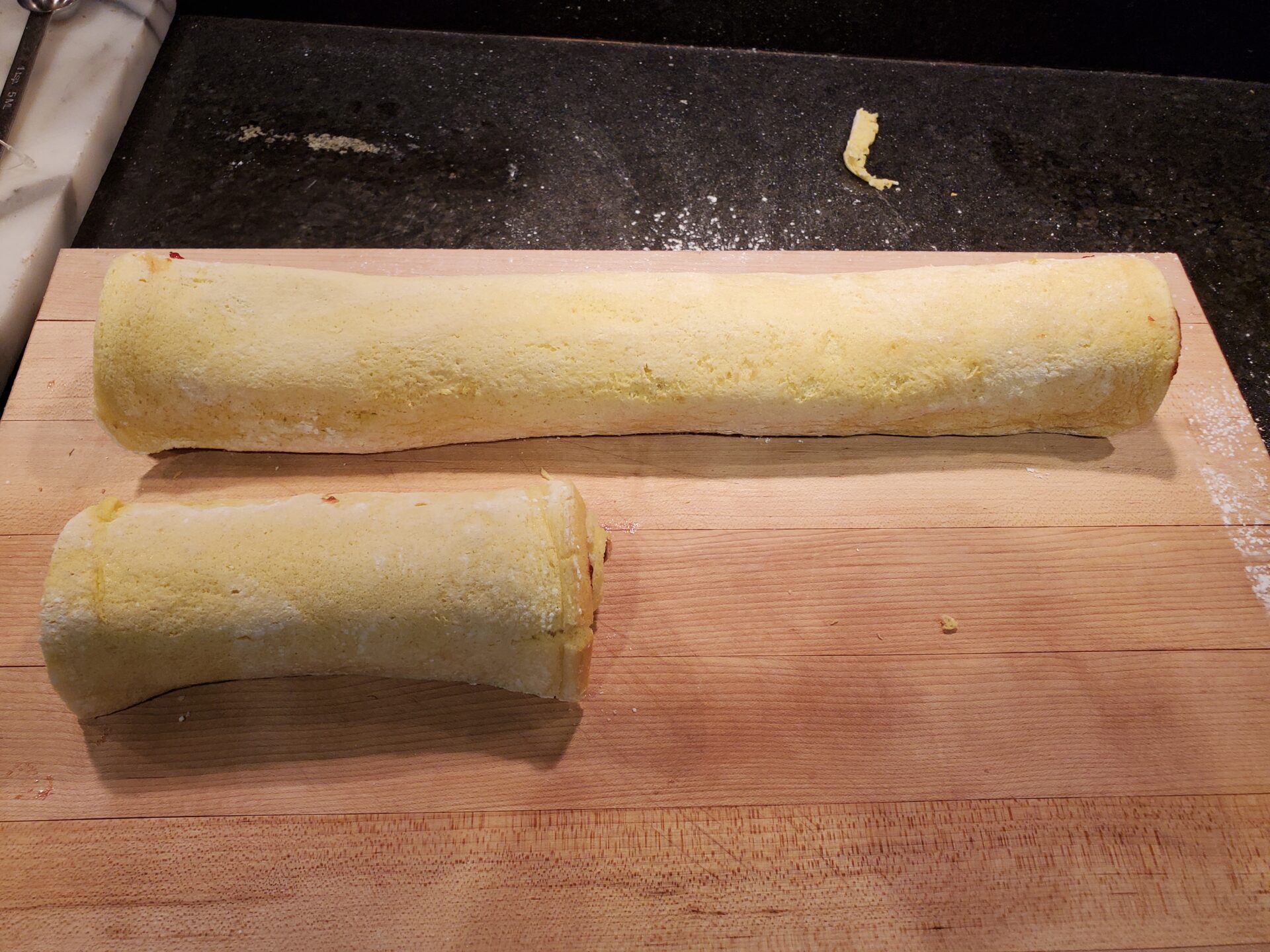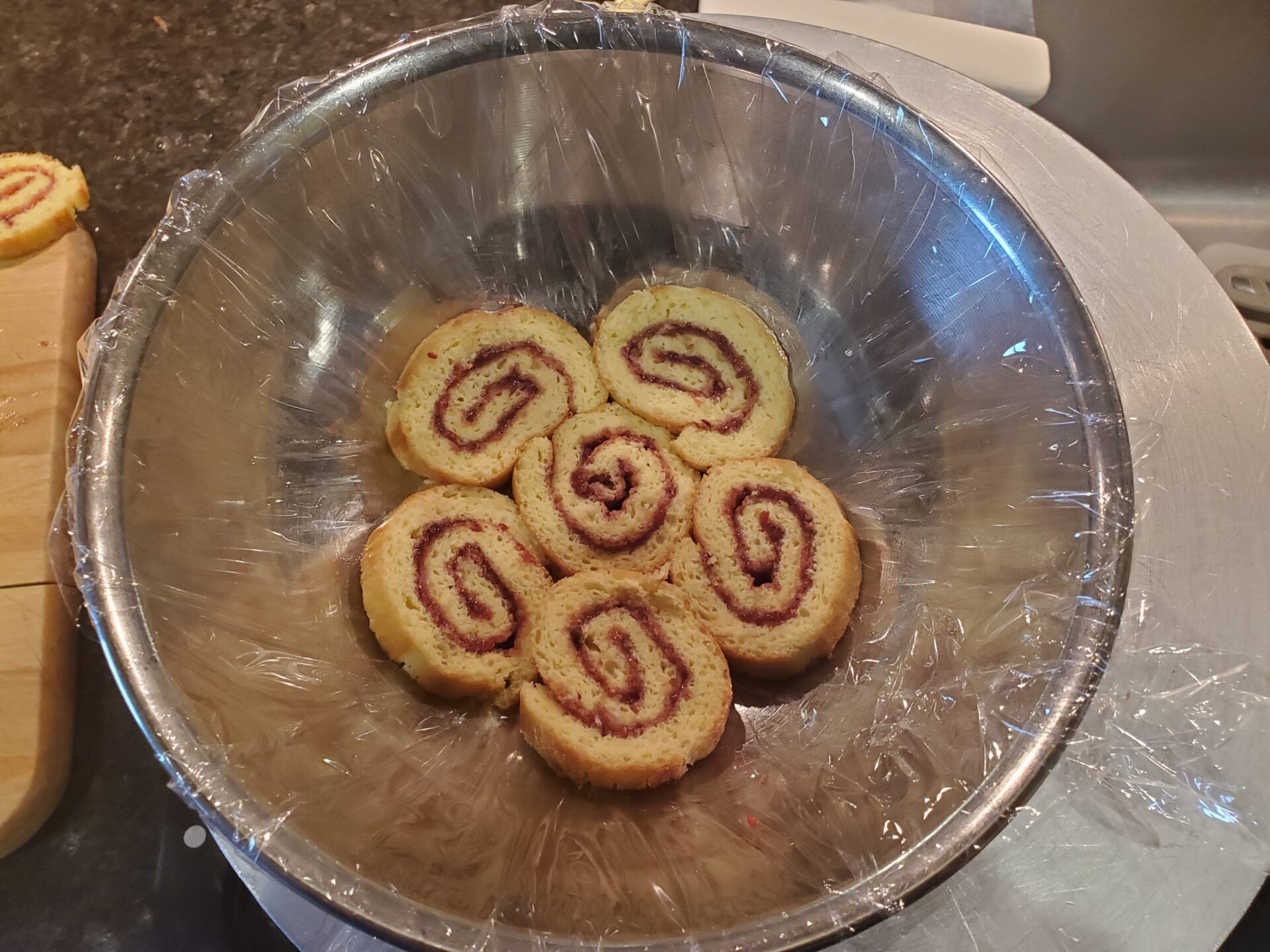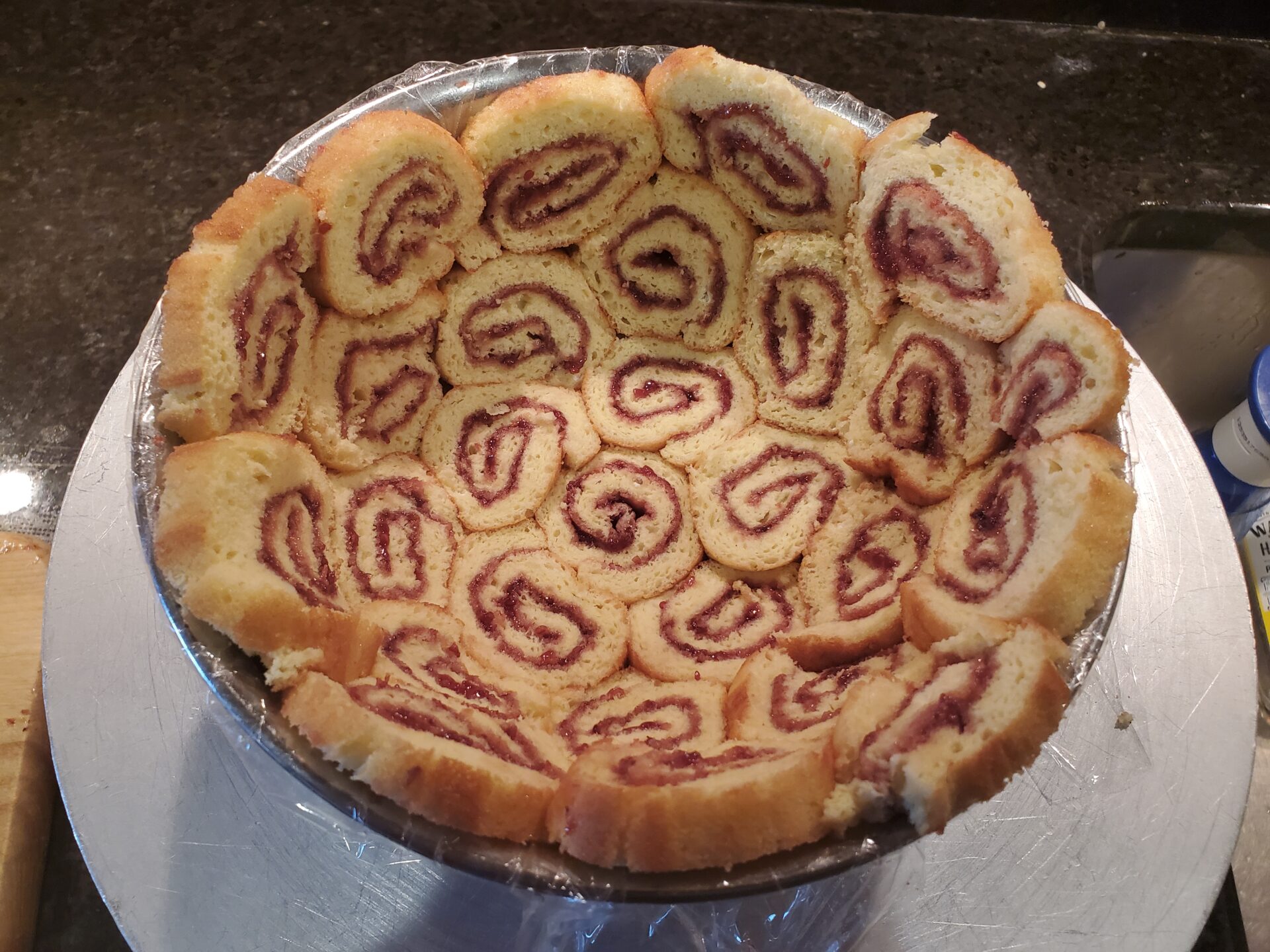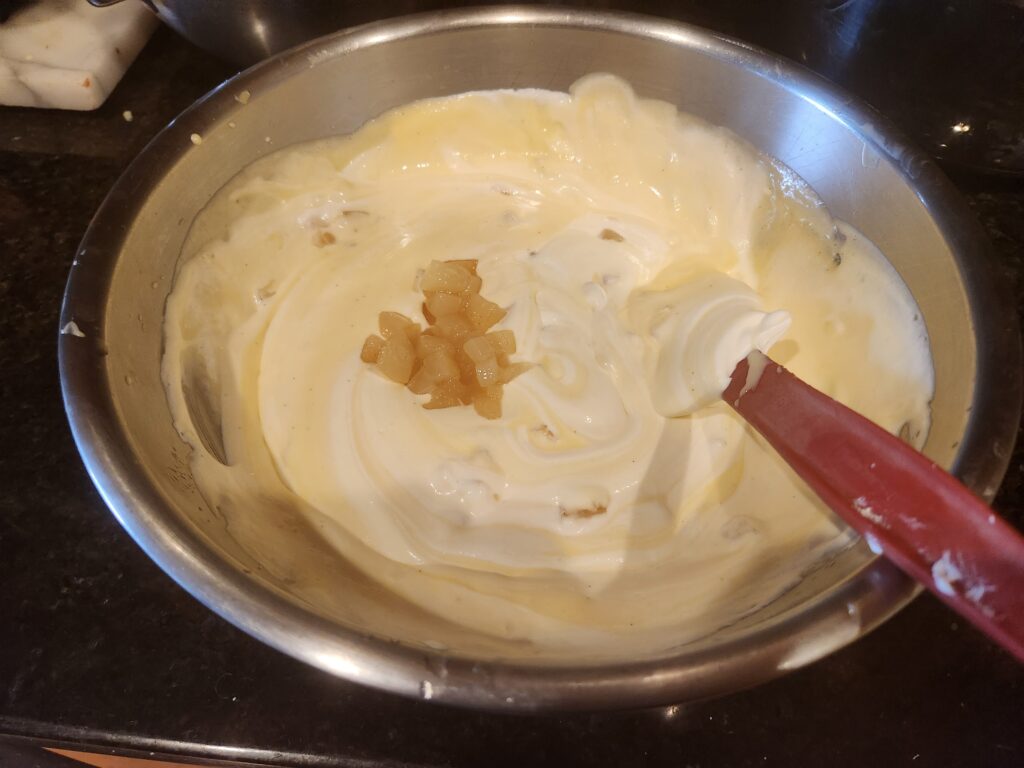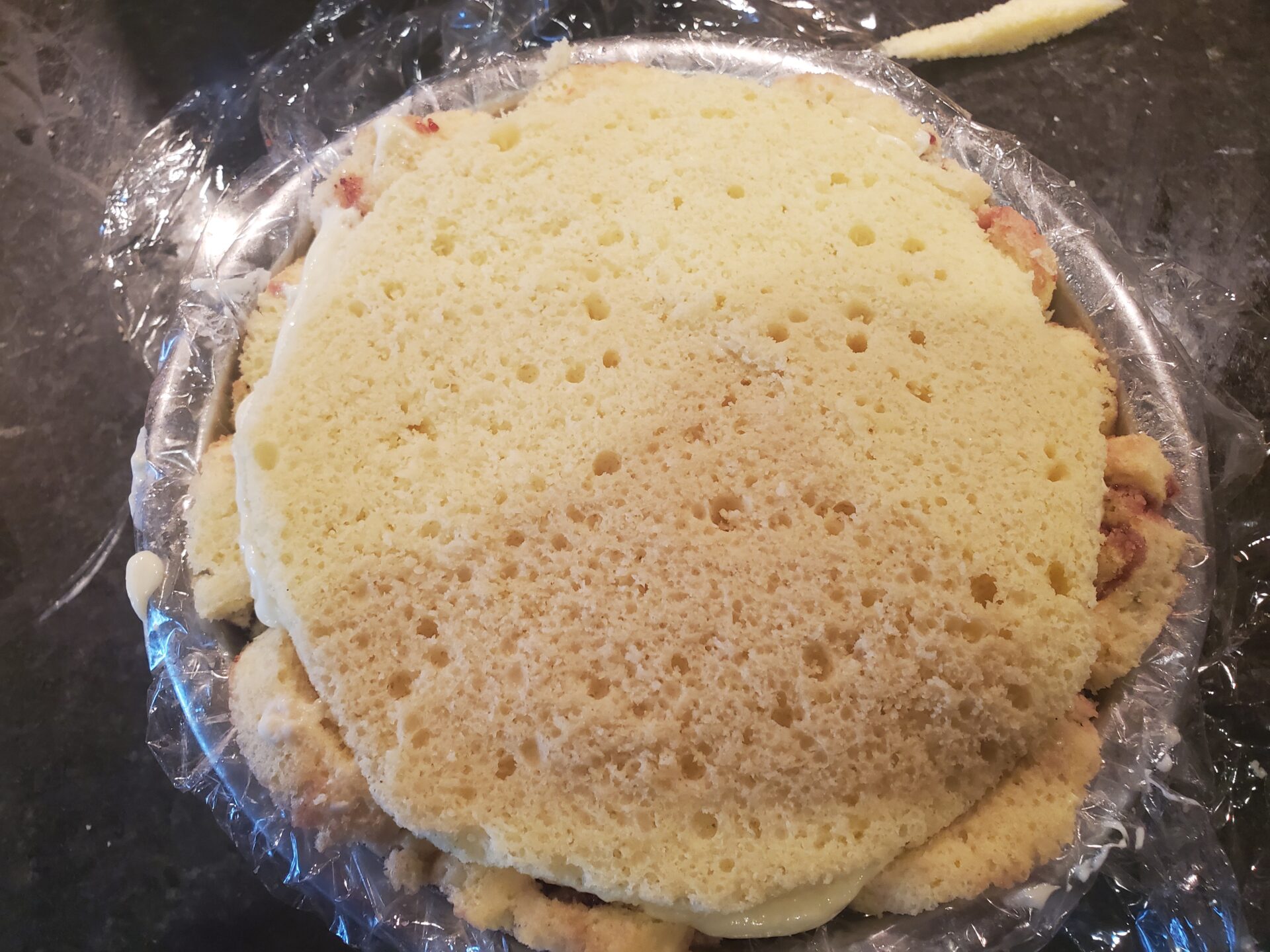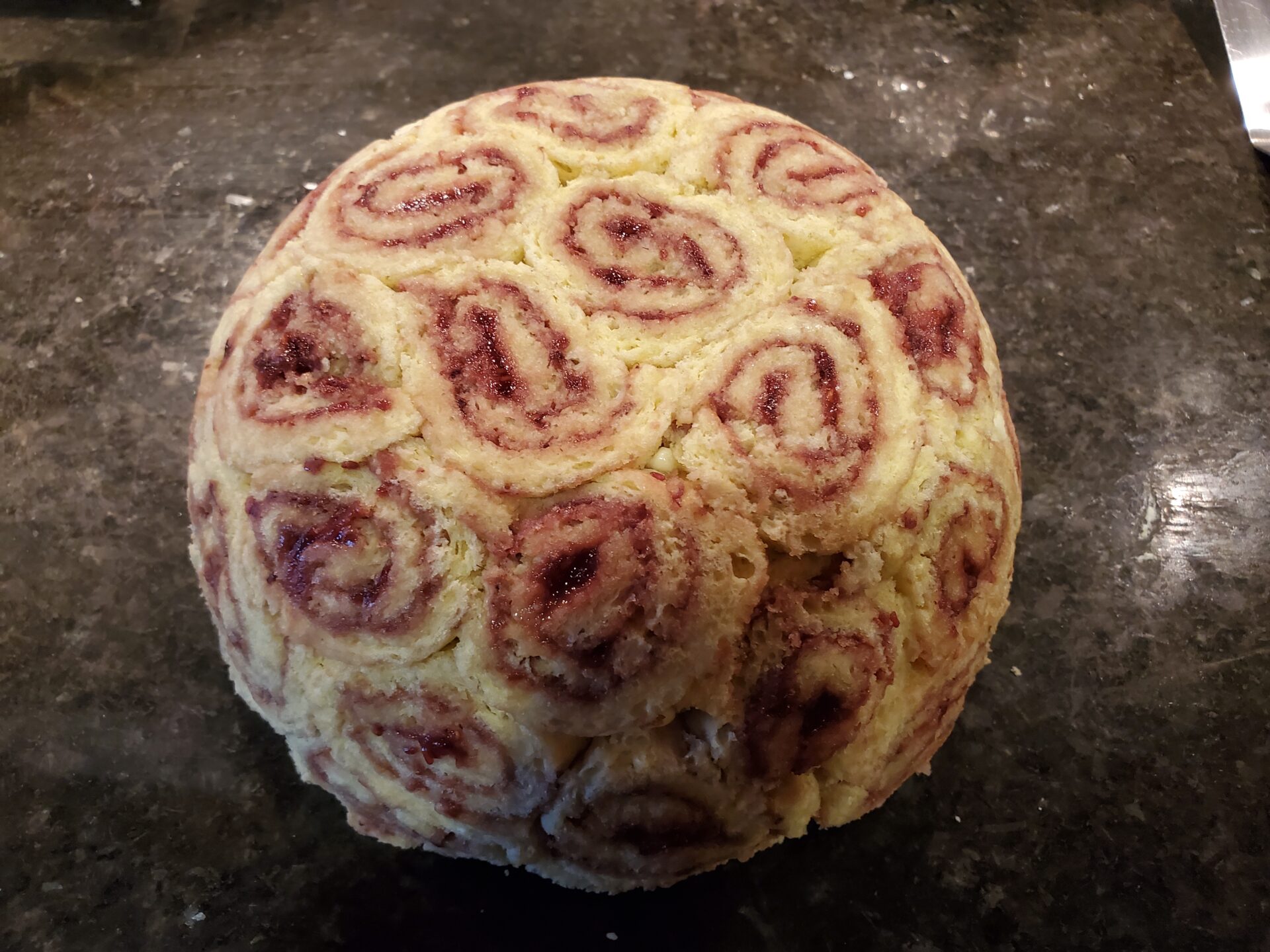Pear Charlotte Royale
For years, the New York Times Sunday magazine section included a Food column from Craig Claiborne and Pierre Franey. This was the first thing I looked at when starting the paper, and many recipes were cut out and put in a “try this in the future” file.
One, entitled “Improving on Charlotte Russe” (April 1980) caught my attention with a beautiful photograph of a Charlotte Royale, which utilizes the same sublime vanilla Bavarian cream as a Charlotte Russe. In the Royale, the Bavarian is poured into a bowl lined with slices of jelly roll, allowed to set, then unmolded and topped with a thin apricot glaze.
Charlotte Royale is on my permanent list of special holiday desserts, so I wanted to include it my inaugural Christmas blog. As I was getting the mise en place together for the classic version, I saw poached pears sitting in a fragrant syrup in my fridge. They were the key ingredient for a pear Bavarian dessert I was working on. The thought entered my mind – I could use the pear Bavarian in place of the traditional vanilla version and create a new Royale. Thus, the Pear Charlotte Royale was born.
I love this particular Bavarian – instead of cream and milk as the base this uses the pear poaching liquid, resulting in a unique, subtly flavored Charlotte, studded with the diced poached pears.
This dessert is a large undertaking but is basically a series of steps that can be done ahead of time. Sponge sheet baking, jelly roll construction, and lining the bowl can all be done up to 2 weeks ahead, and frozen. The pears can be poached up to 5 days ahead and refrigerated in their syrup.
Pear Charlotte Royale screams for raspberry sauce, do take the time for this last step. You will be rewarded with a special holiday dessert experience.
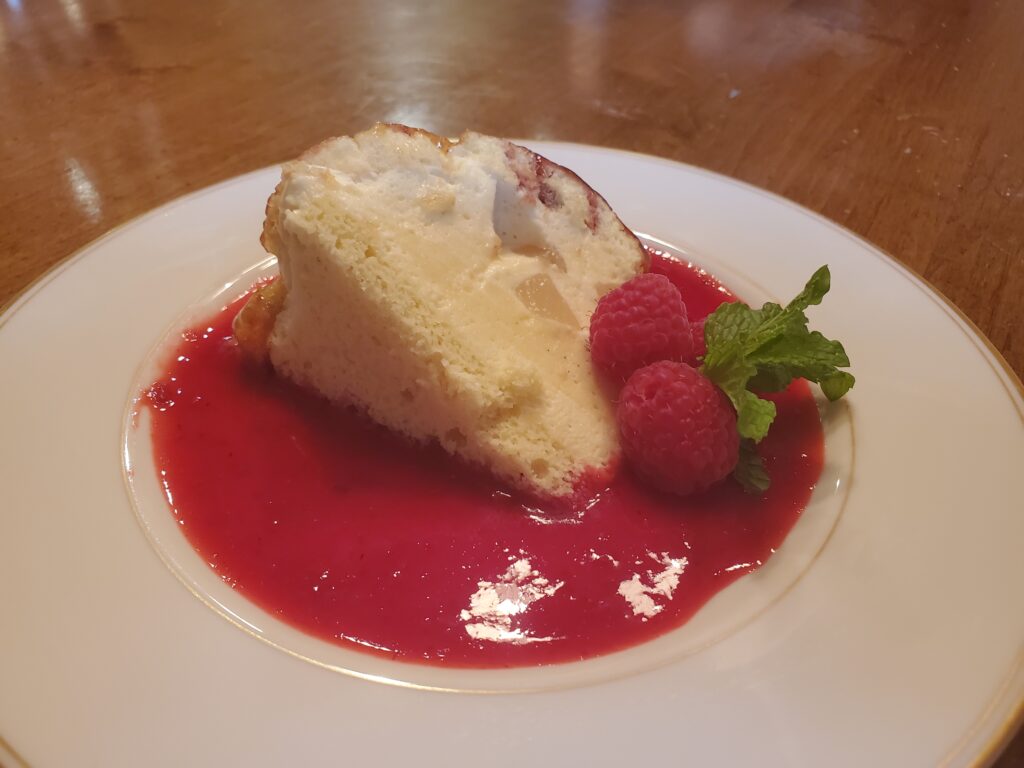
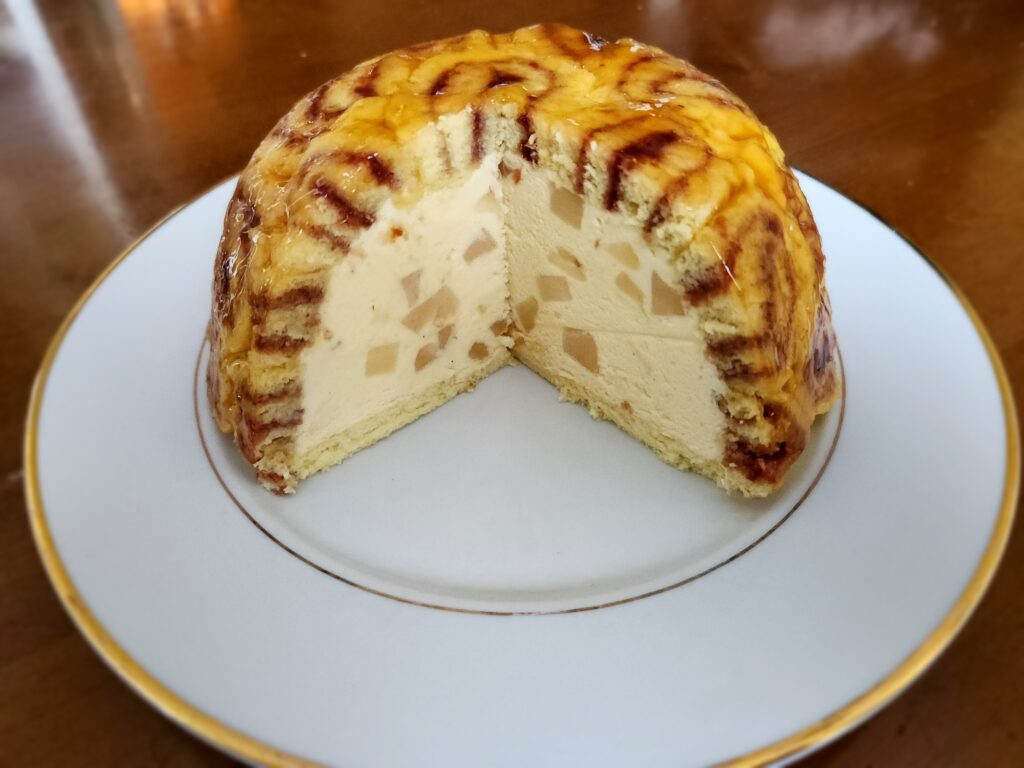
Another reason the “Improving on Charlotte Russe” article stayed with me was the name itself, which had been in my memory bank since childhood. To my parents, Charlotte Russe referred to a special treat, sold from pushcarts, candy stores and bakeries in the New York of their youth. Many discussions of foods from the past included Charlotte Russe, and always brought smiles and a wave of happy nostalgia.
That version involved a thin circle of sponge cake under a generous crown of whipped cream, topped with a maraschino cherry. It was all held together in a handheld cardboard pushup cup, which allowed you to push the sponge cake up from the bottom as you made your way through the whipped cream.
However, that handheld confection was very different from the original Charlotte Russe, which is an elegant dessert consisting of sponge cake, and a Bavarian cream encircled by ladyfingers, created by Marie-Antonin Carême, considered to be the father of classical French cuisine. In his 1852 book on pastry, there is a recipe for “Charlottes à le Parisienne or à la Russe”, with the “à la Russe” being a tribute to his time spent in Russia as the chef for Tsar Alexander I.
How Carême’s elaborate creation became the simplified and beloved sweet of my parent’s generation remains a culinary mystery.
Pear Charlotte Royale
| Yield: 1 Charlotte | # of Servings: 10 | Difficulty: Advanced |
Ingredients:
Poached Pears:
- 1 qt. cold water
- 1 ¼ cup (9 oz / 255 g) sugar
- 1 cinnamon stick
- 1 star anise
- 1 vanilla bean, split
- Zest from ½ lemon
- 2 to 3 Anjou or Bosc slightly soft pears
Jelly Roll and Cake Bottom:
- 2 x Basic Sponge Sheet or 1 Basic Sponge Sheet (double recipe)
- â…“ cup raspberry preserves
Pear Bavarian Cream
- 1 cup (8 fl oz) heavy cream
- 1 tbl crème fraiche (optional)
- 5 large egg yolks
- 3 tbl (1 ½ oz / 43 g) sugar
- 1 pinch salt
- 1 ½ cup pear poaching liquid, hot
- 4 gelatin (gold) leaves (.3 oz / 9 g) 1
- Cold water, as needed
- 1 cup diced poached pears (from above)
Finishing:
½ cup apricot preserves
Sauce:
Special tools and equipment needed:
- 1 small bowl (to form the Charlotte), approximately 7 ¾ “diameter, 2 ½” height, 1 qt. capacity
- 1 medium, heavy bottomed saucepan, about 2 qt. capacity
- Stand mixer with whip attachment, or handheld mixer, or hand whisk
- Fine mesh strainer, small offset spatula, heat-proof mixing spoon or spatula.
- Instant read thermometer
Directions:
Forming the jelly roll and lining the bowl:
- Bake two basic sponge sheets. Let cool.
- To form a jelly roll with the first sheet – turn one pan upside down so the sponge sheet falls onto a confectioners’ sugar dusted silpat or a sheet of parchment paper. Remove the parchment liner from the back of the sponge sheet.
- Using small offset spatula, spread a thin layer of raspberry preserves over the sheet.
- Starting on the long side, roll to a tight a tight roll. Cover with plastic film and set aside.
- Turn out second sponge sheet onto silpat or parchment lightly dusted with confectioners’ sugar.
- Using the small bowl as a guide, cut a circle of cake the same diameter as the bowl. Wrap well and set aside. Make a small jelly roll from part of this sponge sheet to use as necessary to fill the bowl, or for snacking.
- Line the small bowl with a sheet of plastic film.
- Slice the jelly roll into ½” slices. Place one slice in the center of the bowl and continue placing slices against each other, working your way to the top of the bowl. (See pics).
- Continue until the bowl is completely lined with jelly roll slices, filling in any gaps with parts of a slice.
- The bowl may be wrapped well in plastic film and frozen, along with the cake circle bottom, for up to two weeks. Keep frozen until ready to make the Bavarian.
Poached Pears:
- In medium saucepan, make a poaching syrup by combining water, sugar, cinnamon stick, star anise, vanilla bean (with the inner seeds scraped into the syrup), and lemon peel. Stir to combine, and bring to boil over medium heat.
- Simmer for 10 minutes.
- Peel, core, and half the pears.
- Place pear halves in the syrup and gently simmer until the pears are very tender. This could take between 45 to 60 minutes, depending on the ripeness of the pears. To test, remove a pear half, place on a plate, and insert and paring knife.
- Remove from the heat, place on a heat-proof surface and let the pears totally cool in the syrup.
- The pears may then be stored (in the syrup) in the refrigerator for up to 1 week.
Making the Pear Bavarian:
- Place a mixing bowl and hand whisk, or machine bowl and wire whip, in the refrigerator.
- Set a fine mesh strainer over a medium stainless bowl and have a larger bowl with filled about half way with ice and water. These will be used when straining and cooling the custard.
- Drain the diced poached pears of any liquid.
- In a chilled bowl, whip the cream and crème fraiche just until soft peaks. Place in the refrigerator.
- Soften the gelatin leaves by placing in small bowl with just enough water to cover. Set aside.
- Strain 1 ½ cups of the pear poaching liquid into a 2 qt saucepan and bring just to the boil. Keep warm on low flame.
- Beat egg yolks with sugar and salt for 1 minute. There is no need to beat to ribbon stage.
- Temper the egg yolks by slowly beating in about â…“ of the hot syrup, making sure to whisk the egg yolks as the hot syrup is being added.
- Once the egg yolk mixture has been warmed, pour it into the saucepan, and keep stirring until it reaches 185 °F, or coats the back of a spoon.
- Remove from the heat and pour through the strainer into the medium bowl.
- Whisk the mixture to release some of the heat.
- Squeeze the water out of the softened gelatin leaves, add to the hot custard, and whisk vigorously to combine.
- Place the bowl containing the mixture over the ice water and using a clean plastic spatula stir occasionally from the bottom to ensure even cooling and prevent lumps from forming (as the gelatin begins to set).
- Cool just until the mixture begins to thicken, about 65 °F.
- Give the cream one quick whisk by hand to bring it back to correct soft thickness. Gently whisk about ¼ of the cream into the Bavarian, then fold in remainder, adding the diced pears in three stages as you fold.
- Fill the mold with the Pear Bavarian, leaving ¼” at the top. Knock the bowl on the counter to eliminate any air pockets.
- Place the cake circle on the top and using scissors, trim to fit just inside the jelly roll.
- Cover with plastic film and place in refrigerator for at least 6 hours, preferably overnight.
Unmolding and glazing:
- Remove Bavarian bowl from refrigerator and place a flat serving dish over it.
- Invert and use the plastic film to remove the Bavarian from the bowl.
- Heat 1 cup of good quality apricot preserves until hot. Strain through a fine mesh strainer into a smaller saucepan. Thin out with a few droplets of water if necessary to achieve a glaze consistency.
- Brush the Bavarian with a thin coating of the apricot glaze.
- Refrigerate until ready to serve.
Notes:
1 Amazon carries gold gelatin leaf, including a beef-based version – HAODONG Beef Gold Leaf Gelatin Sheets – 200 Bloom.
